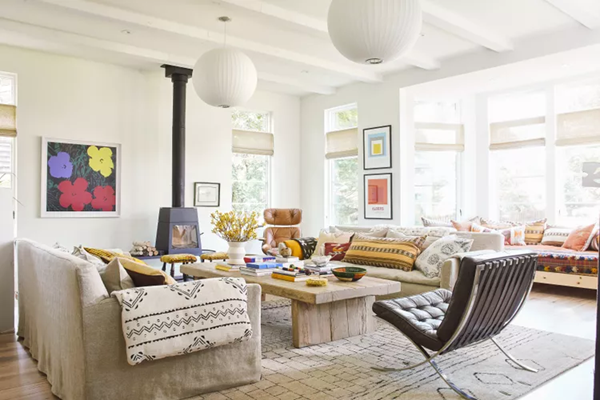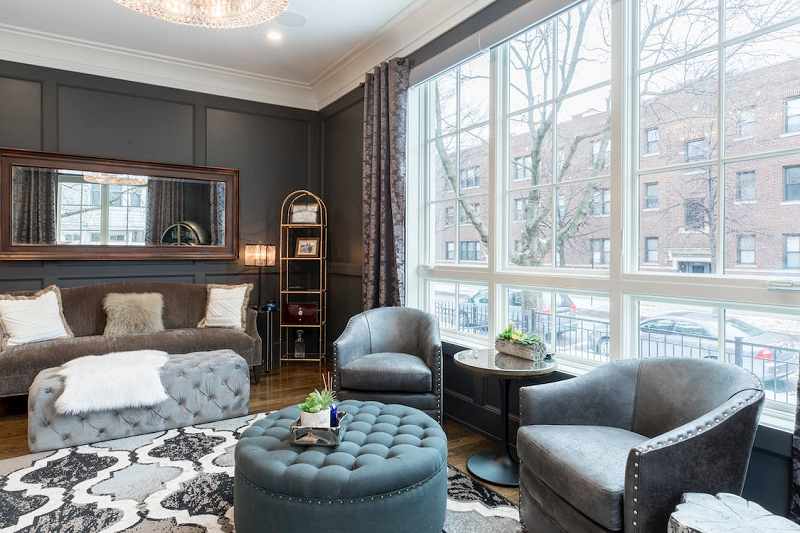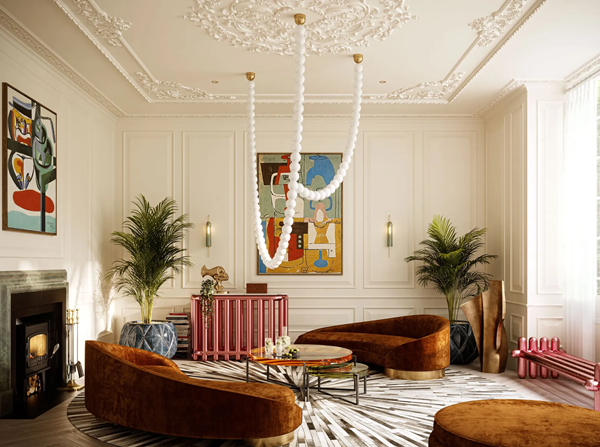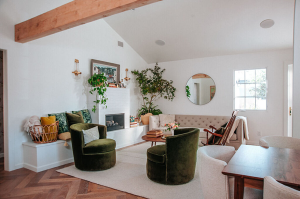Wabi-Sabi decor has been trending for many years, and here’s why! Imagine walking along an ancient forest path, surrounded by towering pines and the earthy scent of decaying leaves. Ahead, a small, intricately built hut made of timber and clay catches your eye. As you approach, you notice the tiled roof with unique imperfections – some tiles chipped, some faded by the elements, yet exquisitely composed. Stepping through the humble doorway into a single tranquil room, a deep sense of calm washes over you.

This space, sparse yet rich in simple beauty, holds the essence of wabi-sabi. This Japanese wisdom finds beauty in imperfection, authenticity in simplicity, and poetry in the impermanence of all things. If this resonates, keep reading as we explore the profound principles and styling ethos of wabi-sabi design. By its end, you’ll have a clear vision for transforming your home into a nurturing haven that celebrates simplicity and reveres the art of the human hand.
What is Wabi-Sabi Decor?

Wabi-sabi decor is all about seeing the charm in things that aren’t perfect. It likes the quirks and flaws that make each item special and one-of-a-kind.
“Wabi-sabi is a way of living that celebrates the beauty of imperfection. It’s about finding peace in the impermanence of things.”
Says Interior Designer, Kelly Wearstler
Some of the key ideas behind wabi-sabi decor are:
- Asymmetry – Things don’t have to be perfectly symmetrical and balanced.
- Roughness – Nicks, scratches, and dents add character.
- Simplicity – Keeping things minimal and uncluttered.
- Modesty – No showing off or bragging with fancy, showy items.
- Intimacy – Surrounding yourself with meaningful objects you cherish.
Instead of generic, mass-produced things, wabi-sabi celebrates unique handmade items. Things like a misshapen ceramic vase made by a potter. Or a naturally knotted wood stool. Or an old metal tray with some rust spots.
“If you are looking for a way to style your space with wall art without breaking your piggy bank, then I recommend reading “10 Surprising Benefits of Printable Wall Art”
The little quirks and imperfect details are what give these pieces their raw beauty and charm. They connect you to the human craftspeople who made them and the natural processes that aged them over time.
Also: How to Choose a Wall Color: A No Fail Formula
The Benefits of Wabi-Sabi Decor

Having a wabi-sabi home doesn’t just make your space look cool and unique. It can actually help you feel more calm and happy too! Did you know that according to Eventbright, 70% of millennials prioritize experiences over things, which aligns with Wabi-Sabi’s focus on creating a calming atmosphere over excessive possessions.
One of the biggest benefits is that it helps you live in the present moment. When you surround yourself with imperfect, naturally-aged items, you appreciate them for what they are right now. Not what they used to be or what they could become.
Wabi-sabi reminds you to slow down and really look at the details around you. To find beauty in the tiny quirks instead of always wanting new and perfect stuff.
It’s a way to cut down on waste too. Instead of constantly tossing things out when they get a little worn, you learn to cherish and reuse them. Giving new life to old, preloved items is part of the charm.
Most importantly, a wabi-sabi home creates a soothing, peaceful space to relax. With its earthy colors, natural textures, and uncluttered simplicity, it’s the perfect oasis to escape our hectic, busy lives. No more stressing over little imperfections – they’re celebrated here!
Also: How To Set Up A Small Home Gym
Emotional/Psychological Benefits

Practicing wabi-sabi principles can have profound impacts on our emotional and psychological well-being. Its emphasis on removing excess cultivates a sense of calm and stillness that counters overstimulation. Prioritizing handmade, naturally imperfect objects over mass-produced items inspires mindfulness by connecting us to the human makers and organic processes behind each creation.
Wabi-sabi’s acceptance of impermanence and transience alleviates anxiety around control, aging, and change. Its focus on finding beauty in simplicity, roughness, and modest materials fosters gratitude by redefining our perceptions of what deserves appreciation. By incorporating living plants and elements from nature, wabi-sabi spaces create a biophilic atmosphere that soothes the mind and body.
Overall, embracing wabi-sabi provides an antidote to the stresses of modern life by nurturing presence, patience and perspective. A 2023 Houzz survey found that 67% of homeowners are looking for ways to create a more serene and comfortable home environment, directly connecting with the core concept of wabi-sabi.
Also: Aesthetic Work Desk Setup Ideas
Sustainable Living

Wabi-sabi harmonizes seamlessly with sustainable living through its promotion of reusing, repurposing and extending the lifecycle of objects. Rather than mindlessly discarding items due to minor imperfections, wabi-sabi values the character and history these perceived flaws can provide. Itsanti-wasteful mindset prioritizes natural, durable materials like wood, ceramics and fibrous plants over cheaply made synthetics.
“True luxury is not about things being perfect, but about accepting imperfection and finding beauty in that.”
Says Interior Designer, Axel Vervoordt
Wabi-sabi advocates for secondhand, vintage, and antique sourcing as a way to reduce consumption while imbuing spaces with unique character. When curation is done thoughtfully, each repurposed piece in a wabi-sabi home has the chance to radiate renewed purpose and beauty. This circular approach where objects transition from raw materials to handmade art to cherished relics aligns with the closed-loop sustainability model.
By rejecting trends of disposable sameness, wabi-sabi spaces embrace the most sustainable design of all – one that harnesses existing materials sustainably while honoring their inherent stories.
Also: 31 Most Important Popular Interior Design Styles You Should Know About
How to Incorporate Wabi-Sabi into Your Home

Creating a wabi-sabi home is all about surrounding yourself with imperfect beauty and unlocking a sense of calm. While it may seem challenging, it’s actually quite simple to adapt this Japanese philosophy into your living spaces.
Declutter
The first step is to declutter ruthlessly. Wabi-sabi embraces minimalism, so you’ll want to remove any excessive knick-knacks, decor and furnishings. Keep only the items that bring you joy or serve a real purpose. For example, clear off those cluttered bookshelves and style them with just a few stacked vintage books, a handmade ceramic piece, and a found object from nature like a piece of driftwood.
Add Natural Elements
Next, focus on incorporating organic, natural materials as much as possible. Wabi-sabi celebrates the innate beauty of materials like wood, stone, clay, linen and rattan. An antique wooden blanket chest with dents and scratches makes a perfect coffee table centerpiece. Use raw edged shelves crafted from salvaged wood to display your favorite objects. Replace artificial light with the warm glow of beeswax or tallow candles.
Add Furniture Pieces
When it comes to furnishings and accents, prioritize handmade or vintage pieces with a narrative. Artisanal ceramics like a hand-thrown, asymmetrical vase or textured glazed bowl lend perfectly imperfect character. Antique metal trays naturally formed with patina create intriguing wall hangings. And textiles like soft, undyed linen curtains or a chunky, hand-loomed area rug add wonderful visual and tactile texture.
Add Aged Decor Pieces
Wabi-sabi is about appreciating the inherent beauty and history in objects that have aged over time. Celebrate the scoring on a found piece of driftwood. Style a raw-edged wooden slab as a simple side table, its natural imperfections and knots fully exposed. Hang an old metals sign with rusting edges as sculptural art.
Also: Step-by-Step Guide to Declutter Your Home
Add Greenery
To really drive home the connection to nature, incorporate living plants like a potted fiddle leaf fig tree, hanging air plants or a serene indoor garden. Let the outside in by maximizing natural light through uncovered windows.
Add Negative Space
When pulling a wabi-sabi room together, arrange pieces thoughtfully with plenty of negative space surrounding each object to allow its story to breathe. Resist the urge to overcrowd and clutter up the space. The magic lies in the edited curation of meaningful, imperfect pieces that evoke a sense of history, tranquility and connection to the natural world.
“Wabi-sabi is more than just an aesthetic; it’s a philosophy that teaches us to appreciate the beauty of the understated and impermanent.”
Says Architect, John Pawson
How to Decorate Your Home In Wabi-Sabi Style
Wabi-Sabi In Your Living Room

For the living room, start with a nice worn leather sofa or armchair that has gained a beautiful patina over time. Accessorize with handmade ceramic vases or bowls that have unique, organic shapes and glazing imperfections. An antique trunk or storage chest with dents and scratches makes a great coffee table. Hang some simple linen curtains that are intentionally left un-ironed for a relaxed, natural look. Finally, add living elements like a potted tree or bonsai plant.
Also: How to Choose The Right TV Size to Decorate Your Living Room
Wabi-Sabi In Your Bedroom

In the bedroom, use a low, minimalist platform bed made from natural, untreated wood that shows its natural knots and grain patterns. Skip the headboard and lean an antique wooden door behind the bed instead.
For lighting, opt for a simple woven rattan lamp that casts a warm, diffused glow. Store clothes in a vintage armoire with some paint chipping off for character. Place a handmade ceramic vase or bowl on the dresser to hold your jewelry. Finish it off with crisp, undyed linen sheets and a cozy, chunky knit blanket.
Also: How to Arrange a Small Living Room: The Ultimate Guide
Wabi-Sabi In Your Bathroom

The bathroom is a great place for wabi-sabi style too. An antique vanity with some wear and tear makes a unique bathroom sink cabinet. Use plain, pitted concrete or stone vessels as sinks. For the mirror, find an old vintage one with imperfections and oxidation around the edges. Place a wooden stool with a natural, organic shape in the corner to hold towels and products. Finish the look with some living greenery like a potted snake plant or hanging air plants.
With wabi-sabi, it’s all about highlighting those imperfect, natural, handmade and time-worn elements. So look for pieces that showcase the human touch and Effects of aging. Mixing textures like wood, metal, linen and clay helps create that serene yet rustic feel. The key is keeping it simple and uncluttered to really let the beauty of the individual elements shine.
Also: Tips To Achieve a Modern Design Space
Wabi-Sabi Styling Tips

Mastering the art of wabi-sabi styling starts with a purposeful edit that clears the space of unnecessary clutter and distraction. Focus on furnishing with understated, organic shapes and tonal palettes drawn from nature like creams, browns, greys, blacks, deep greens and rich terracottas. Incorporate a variety of textures through woven rattan, raw wood, nubby linen and glazed ceramics.
Prioritize leaving ample negative space around each object to allow its unique narrative and character to breathe. Whether it’s a vintage armoire, antique wooden stool or hand-thrown pot, display each wabi-sabi statement piece separately to highlight its asymmetry and imperfections.
Group accessories like ceramic bottles, wooden sculptures or antique trays into curated vignettes for visual intrigue. For lighting, opt for the ambient warmth and movement of candles or rattan lanterns. And perhaps most importantly – introduce living elements like branches, flowers, bonsai trees and hanging planters to cultivate a grounding connection to the natural world.
Also: Mastering the “One Hour Method” for a Spotless Home: A Comprehensive Guide
Wabi-Sabi Maintenance

Preserving the exquisite imperfections and patinas of wabi-sabi decor requires a gentle, natural approach to cleaning and maintenance. For untreated woods like bowls, shelves or furniture, use a soft dry cloth for dusting and occasionally refresh with a natural wax polish designed for raw wood pieces. Woven rattan, bamboo and abaca pieces can be brushed clean with a stiff brush then wiped down with a damp cloth.
Restore dull, dried ceramics by buffing with a walnut shell cleaner or applying a diluted white vinegar solution with a soft cloth. If repairing any nicks or scratches, use a complementary natural medium like beeswax or wood putty rather than synthetic sealants that can cause further damage over time.
Displaying ceramics, candles and metallic items on naturally non-slip surfaces like linens or wood eliminates sliding and potential damage. Overall, using biodegradable and plant-based formulas while avoiding harsh chemicals preserves the aged beauty of wabi-sabi pieces.
Also: Best Paint Wall Colors That Increases Your Listing’s Value
Wabi-Sabi Decor Style Vs Japandi Decor Style

While wabi-sabi and Japandi both draw inspiration from Japanese aesthetics, there are some distinct differences between the two styles. Wabi-sabi leans heavily into the concepts of imperfection, asymmetry, and appreciating the natural aging process. It embraces a more rustic, weathered look with handmade pieces that showcase the human touch and organic irregularities.
Japandi Decor Style

Japandi decor style, on the other hand, blends Japanese minimalism with Scandinavian functionality and simplicity. It has a more refined, polished look with clean lines and an edited mix of materials like light woods, rattan, and muted colors.
Wabi-sabi highlights natural flaws as a form of beauty, while Japandi seeks a more curated, pared-down perfection. Though both styles utilize natural elements and strive for a serene, uncluttered feel, wabi-sabi is more influenced by the philosophy of acceptance of transience and impermanence represented through imperfect, time-worn objects.
Also: How to Reduce Visual Clutter in Your Home in 5 Easy Steps
Most Popular Post:
10 Surprising Benefits of Printable Wall Art
How to Choose The Right TV Size to Decorate Your Living Room
The ultimate Smart Home Design Guide: Automate your life
Tips for Home Decorating on a Budget: Where to Splurge and Save
10 Best Couch Colors That Make a Room Look Bigger
Conclusion
At its core, wabi-sabi decor is about finding beauty in imperfection and embracing a slower, more mindful way of living. It’s the antidote to our mass-produced, disposable culture that constantly pushes newness and perfection.
By surrounding yourself with naturally imperfect, handcrafted and time-worn objects, you celebrate the human touch and honor each piece’s unique story and journey. Wabi-sabi reminds us to appreciate the simple joys of life, like the shifting play of light across a raw wooden surface or the tactile beauty of a hand-thrown ceramic bowl.
More than just an interior design trend, wabi-sabi is a philosophy that teaches us to accept the transient nature of all things. The nicks, scratches, faded colors and dents are not flaws, but exquisite reminders of the cycles of life, growth and eventual decay that all objects undergo.
By inviting this wabi-sabi mindset into your home, you create a nurturing sanctuary that quiets the external noise and brings a profound sense of peace, balance and harmony. Furnishings are pared down to only the essentials, while negative space allows each piece to breathe. Natural elements like vegetation and handcrafted ceramics forge a grounding connection to the earth.
If the simplicity, authenticity and poetic melancholy of wabi-sabi style resonates with you, take the first step today. Slowly, thoughtfully begin editing your living spaces down to their essentials. Replacing disposable with durable, replacing showy with subtle, replacing perfection with personality. You’ll be amazed at the serenity you cultivate.
Wabi-Sabi Decor-FAQs
Q: Isn’t wabi-sabi decor just using old, beat-up stuff? Isn’t that kind of ugly?
A: Not at all! Wabi-sabi is about appreciating the beauty and stories that worn, naturally-aged objects possess. But those pieces are carefully curated and meant to spark joy, not look neglected. There’s an art to highlighting each object’s innate character and unique narrative.
Q: How can I mix wabi-sabi with my existing decor?
A: Start by editing down any unnecessary clutter and replacing disposable décor items with more permanent pieces made from natural materials like wood, clay, linen. Then incorporate wabi-sabi elements like handmade ceramics, antique wood pieces, and earthy textiles one at a time. It can blend seamlessly with other styles!
Q: Does wabi-sabi decor cost a lot to achieve?
A: Absolutely not. Wabi-sabi embraces finding beauty in the most humble objects and materials. Things like driftwood, raw-edged shelves, potted plants and hand-me-down items can all be incorporated. Hit up thrift stores, flea markets and your own basement for aged, imperfect treasures. It’s about the thoughtful curation, not big bucks.
Q: How do I prevent my wabi-sabi home from looking cluttered?
A: By keeping the overall aesthetic extremely pared down and minimal. Each wabi-sabi piece should have ample breathing room surrounding it, so edit ruthlessly. Use open shelving sparingly and stick to just a few larger statement items in each space. Embrace negative space!
Q: Are there any tricks for adding wabi-sabi to a modern home?
A: Absolutely! Wabi-sabi pieces work beautifully as counterpoints in sleek, modern spaces. Something like a live-edged slab as a dining table grounds the space, while hanging vintage signage as art adds soul. Mix in ceramics, raw wood and nubby linen to soften modern lines. But stick to a disciplined edit.
CATCH THE LATEST IN HOME DECOR TRENDS:

Steal These 15 Expert-Approved Decorating Secrets

How To Accessories Your Living Room

Small Space? 10 Ways To Make A Room Appear Bigger

Make Your space Look Expensive
GET CAUGHT UP ON ALL THE INSPIRING DECOR TIPS:

18 Fresh Decorating Ideas To Update Your Fireplace

How To Create An Art Gallery Wall
